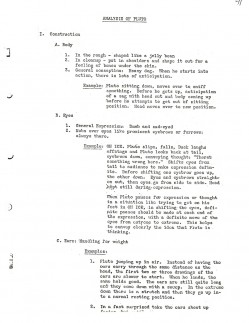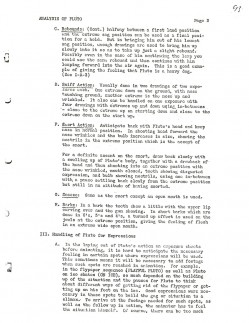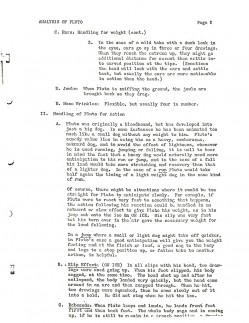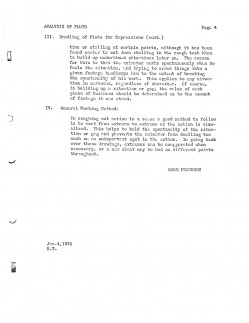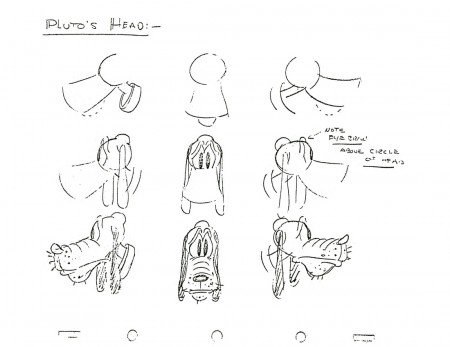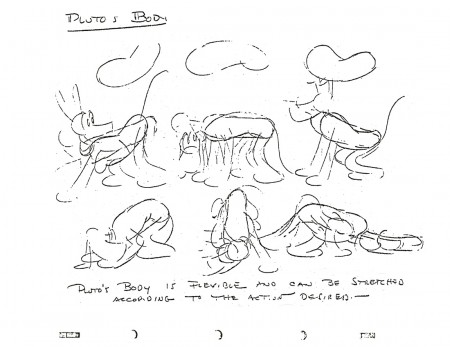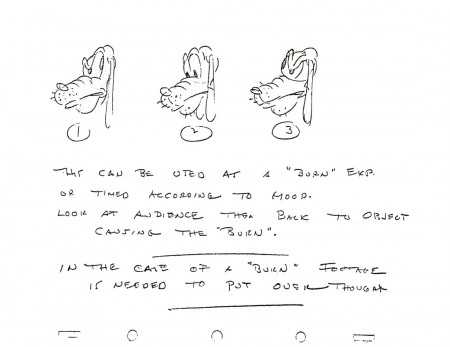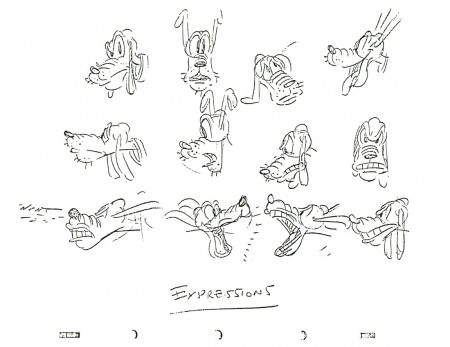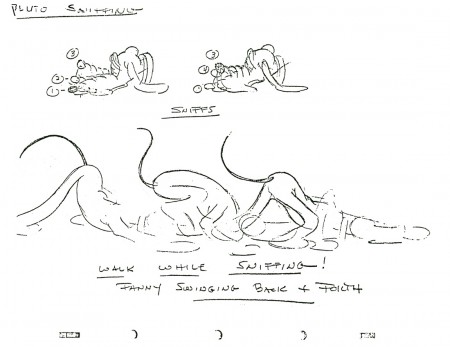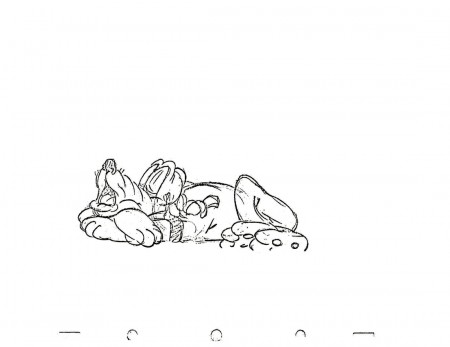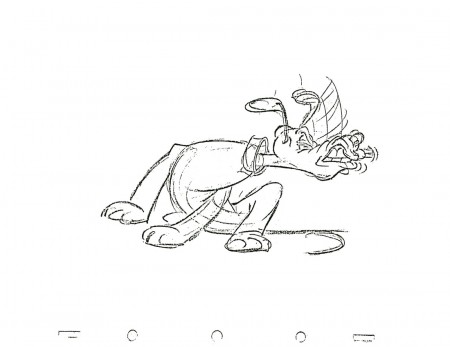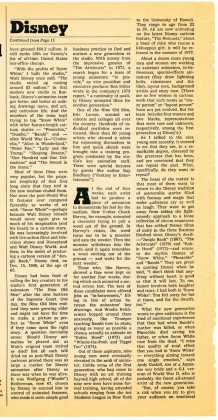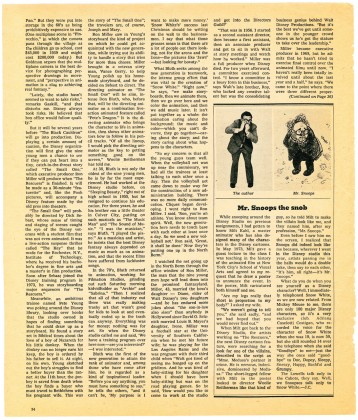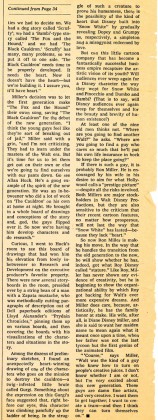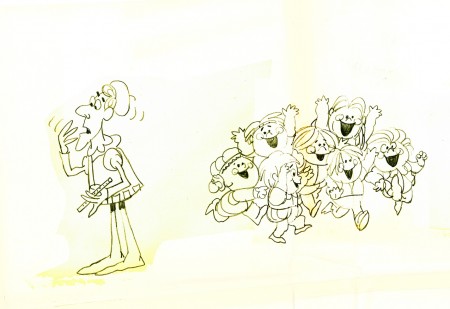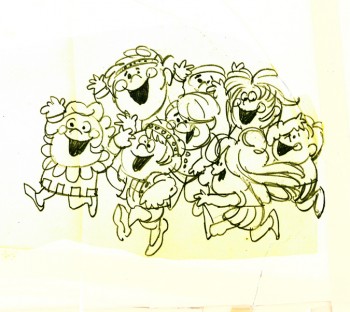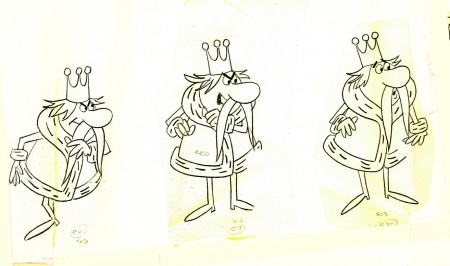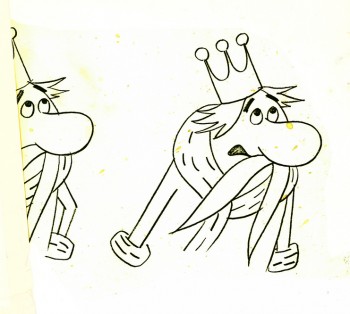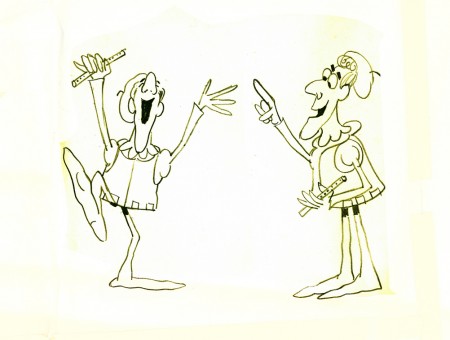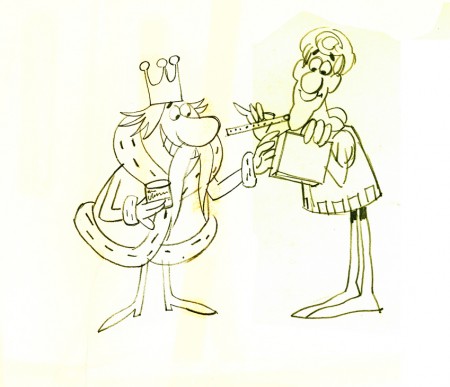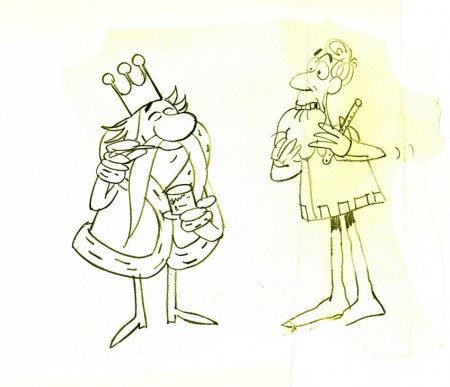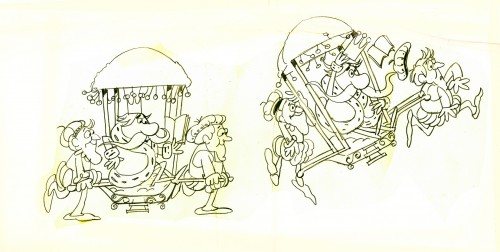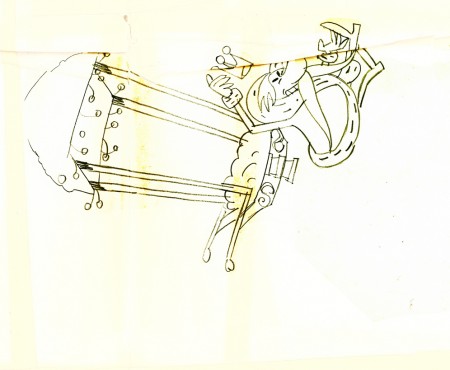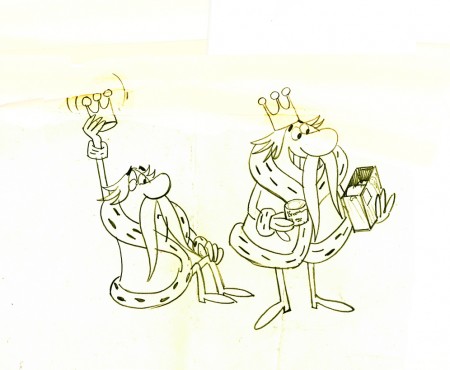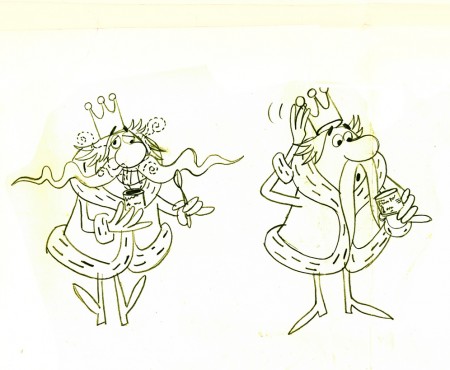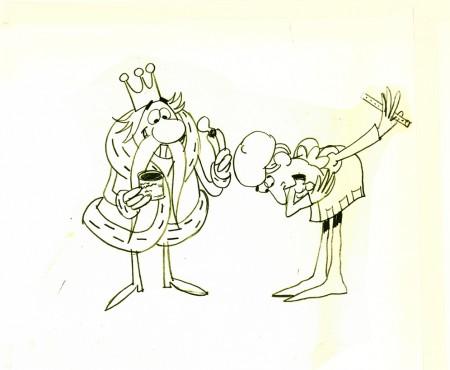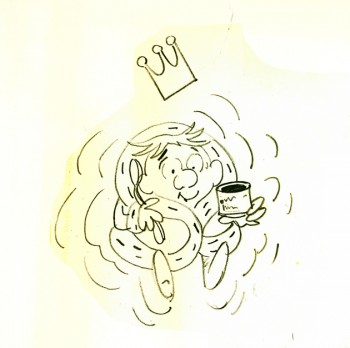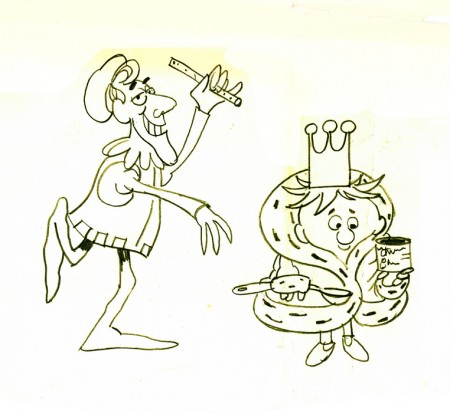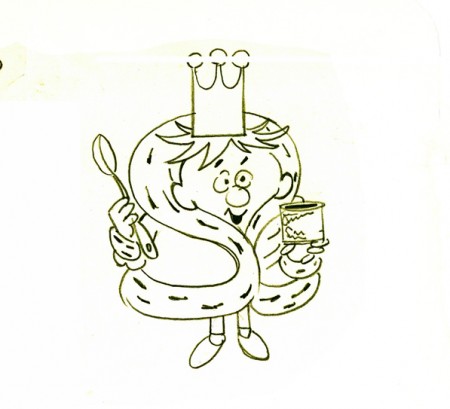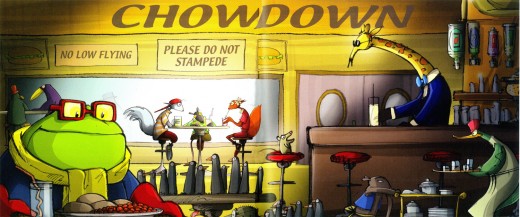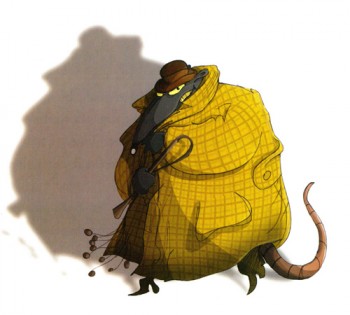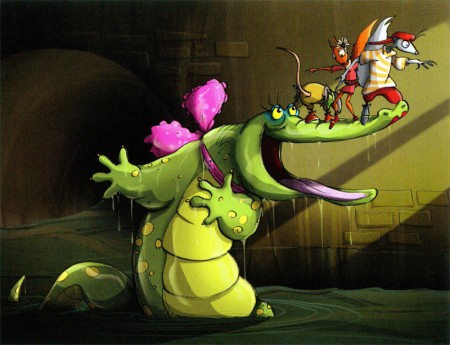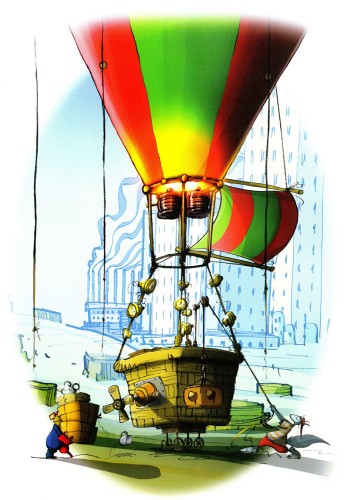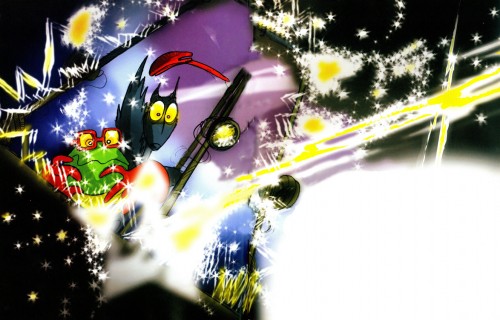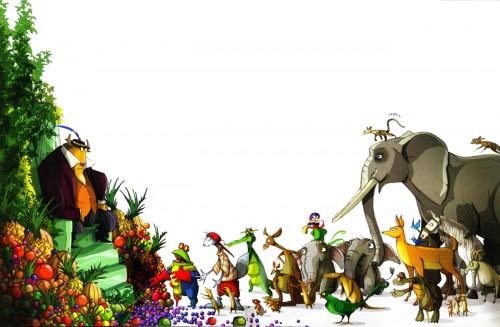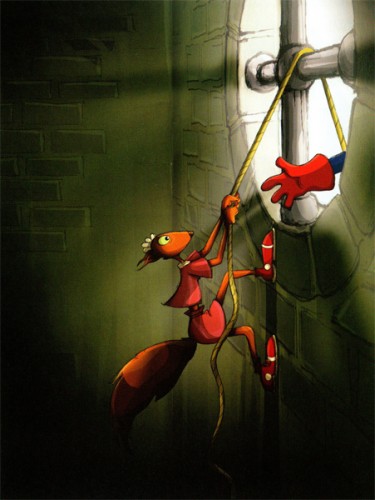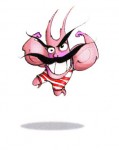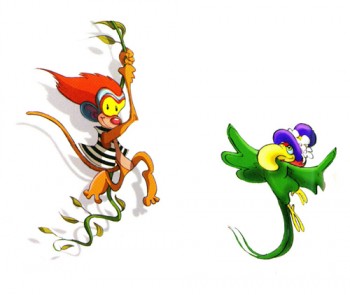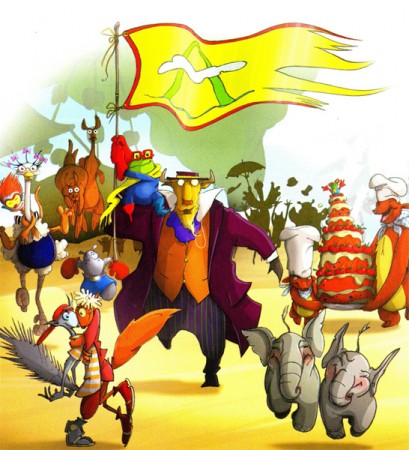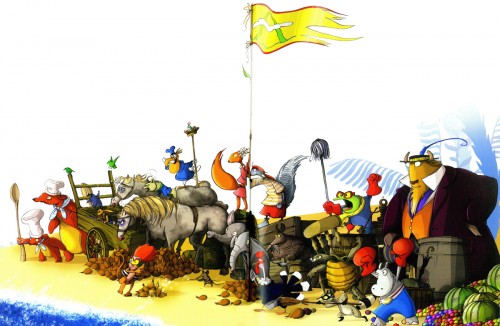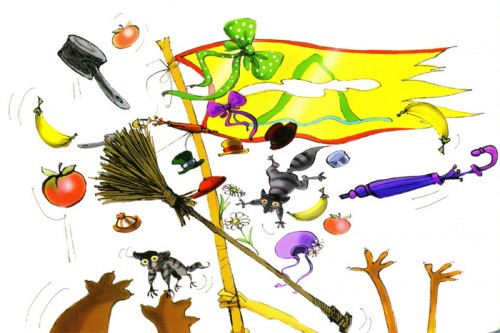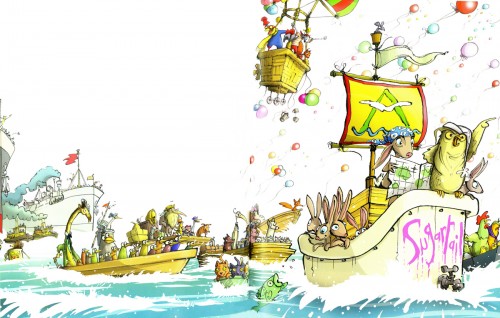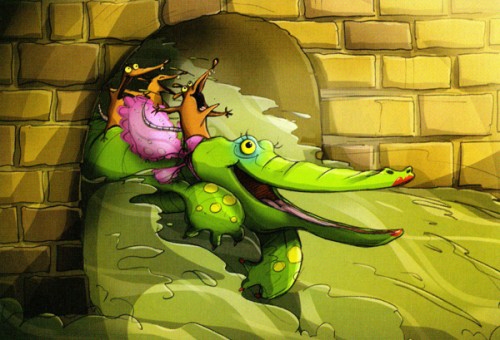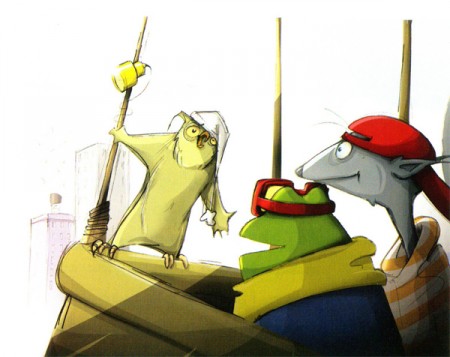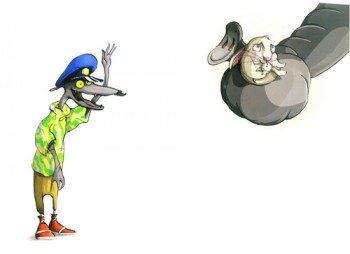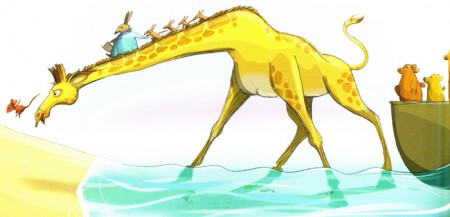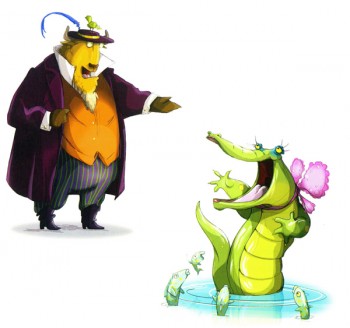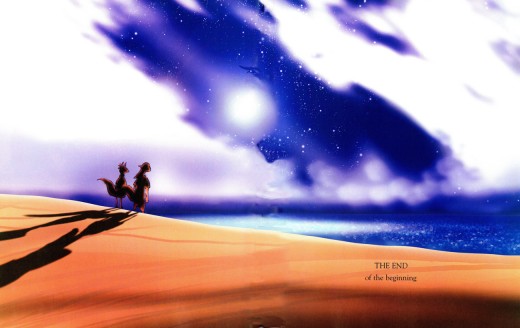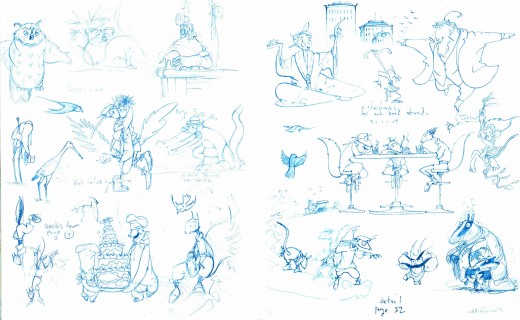Monthly ArchiveJuly 2009
Daily post &Disney &Music &UPA 31 Jul 2009 07:16 am
Animation Music
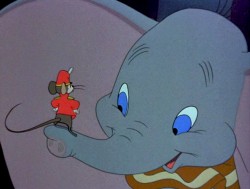 - There’s an extensive review of the music for the Disney animated features, from Dumbo on up through the Fifties. The article was written by Ross Care who is a composer and a film music historian specializing in animation. This was originally written for Cinemascore and can be found on their site – here.
- There’s an extensive review of the music for the Disney animated features, from Dumbo on up through the Fifties. The article was written by Ross Care who is a composer and a film music historian specializing in animation. This was originally written for Cinemascore and can be found on their site – here.
The article gives reports on the music of composers Oliver Wallace, Paul Smith, Ed Plumb and Charles Wolcott. It talks about Dumbo and the post Dumbo features: Victory Through Air Power, Saludos Amigos, and The Three Caballeros. Make Mine Music, Melody Time, Song Of The South, So Dear To My Heart, Fun And Fancy Free, Ichabod And Mr. Toad as well as Cinderella, Peter Pan and Alice in Wonderland.
If you have any interest in the history of film music, particularly applicable to the Disney films, this is worth reading.
- Here’s a review of the film music of UPA written back in the Fifties for Films In Review magazine. I don’t have the exact date of this article I’d saved for the past thirty years.
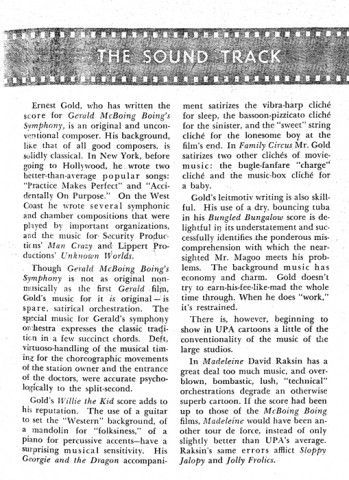 1
1 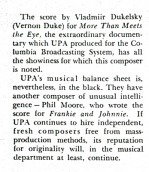 2
2(Click any image to enlarge.)
Commentary 30 Jul 2009 07:18 am
Redos
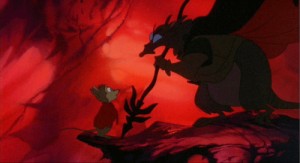 - The news screamed out this week that The Secret of Nimh (otherwise known at Mrs. Frisby and the Rats of NIMH) would be redone by Paramount. Obviously, this wasn’t the film that would save animation, and the new version won’t help much either. It’ll end up a cg/Live Action combination equal to that Guinea Pig
- The news screamed out this week that The Secret of Nimh (otherwise known at Mrs. Frisby and the Rats of NIMH) would be redone by Paramount. Obviously, this wasn’t the film that would save animation, and the new version won’t help much either. It’ll end up a cg/Live Action combination equal to that Guinea Pig
movie that just opened to big box
The old fashioned Secret of NIMH from Don Bluthoffice success.
We’ll have cgi rats and mice running around a live action farm environment chatting away. The film will be written and directed by Neil Burger who did that smash success, The Illusionist, a couple of years back.
One wonders how Don Bluth feels about this. We’ve already had The Chipmunks reanimated in some horrible incarnation of the original Format Films’ animated characters, and we’ve seen Scooby Doo, Garfield and Rocky & Bullwinkle turned into cgi clones of the definitely 2D characters. All terrible movies.
Now we get to witness serious feature animated films reworked into cg monstrosities. Perhaps Disney will take the cue and do a cg/Live Action version of Lady and the Tramp or Snow White or, dare we hope, Fantasia.
I read today about that the “auteur” Zhang Yimou is reamking the Coen Bros. film, Blood Simple. I wonder if any purists would complain if they decided to turn some Live Action gems into cg films. How about Citizen Kane? or Gone With the Wind? The Wizard of Oz is just waiting for the call. After all Tim Burton is doing Alice in Wonderland, and Zemeckis is
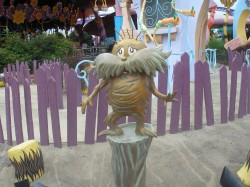 crowing about The Christmas Carol with Jim Carrey doing 10 different roles. (Is there any film that Jim Carrey can’t do?)
crowing about The Christmas Carol with Jim Carrey doing 10 different roles. (Is there any film that Jim Carrey can’t do?)
Word has also come that Universal is about to make Dr. Seuss’ book The Lorax into a 3-D CG animated feature. After the modest financial success of the Blue Sky feature, Horton Hears a Who, why shouldn’t Universal jump into the ring? It has to be better than DePatie-Freleng’s version. At least it’ll stretch the delightful book even longer.
The Lorax
Are there ANY original ideas out there? Has the entire Hollywood world gone so vapid that they can’t come up with anything original?
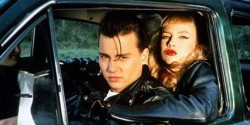 But then this isn’t just the case with Hollywood features; Broadway is going down the same road. There are dozens of shows coming to Broadway that are reworked movie scripts. Everything from 9 To 5 to Cry-Baby have come and gone on the once great thoroughfare (now parking mall, courtesy of Mayor Bloomberg) Broadway. Disney has Cry-Baby the movie
But then this isn’t just the case with Hollywood features; Broadway is going down the same road. There are dozens of shows coming to Broadway that are reworked movie scripts. Everything from 9 To 5 to Cry-Baby have come and gone on the once great thoroughfare (now parking mall, courtesy of Mayor Bloomberg) Broadway. Disney has Cry-Baby the movie
paved the way for many others; The Little Mermaid
is about to close.
Word that 101 Dalmatians, the Musical has been touring everywhere. It’s not a Disney show, but they’re trying to play off the Disney cache. But then, it’s not a Broadway show either, even though “Broadway” is mentioned numerous times on their website. 15 live dalmatians on a theatrical stage; imagine the fun.
It’s obvious that animated films are the last place to find any original thought. Up and Wall-E from Pixar, Shrek and Kung Fu Panda from Dreamworks, Ice Age and The Fantastic Mr. Fox from Blue Sky.
Then the Studios can make live action/animated versions of these films, then Broadway can do their shows. Oh, wait. Shrek is already failing on Broadway. There’s always room for those Madagascar penguins.
Hopefully, Independent animated features will get into the act: the musical Triplettes of Belleville is perfect for Broadway, and I can already see the musical version of Waltz with Bashir and Bill Plympton can try to compete with Mamet with Idiots and Angels.
After writing this, I caught the Cartoon Brew feature about this very thing. I guess it’s enough to catch your breath if you love animation.
Animation Artifacts &Articles on Animation &Disney 29 Jul 2009 07:47 am
Pluto models
 - When I posted the Goofy model notes I thought that I’d finished posting all that I had. Well I’ve just come up with this series of excellent lecture notes on drawing Pluto and his character. Ted Sears leads us to Norm Ferguson, who was the promary speaker for this lecture given to the Disney animation group back in 1936. They gave up drawing these characters so beautifully way back in the Thirties.
- When I posted the Goofy model notes I thought that I’d finished posting all that I had. Well I’ve just come up with this series of excellent lecture notes on drawing Pluto and his character. Ted Sears leads us to Norm Ferguson, who was the promary speaker for this lecture given to the Disney animation group back in 1936. They gave up drawing these characters so beautifully way back in the Thirties.
These finish off the character analysis lecture notes I have. You can find those for Mickey, Donald and Goofy elsewhere on this blog.
An edited form of these notes were published in Frank Thomas & Ollie Johnston‘s The Illusion of Life.
Here are the Pluto notes:
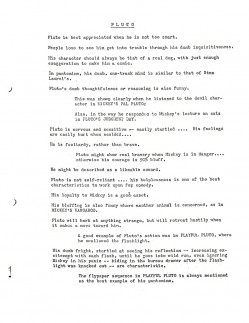 1
1 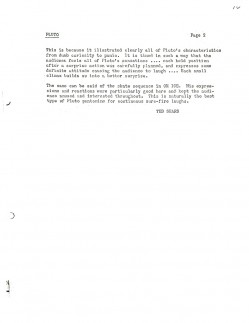 2
2(Click any image to enlarge.)
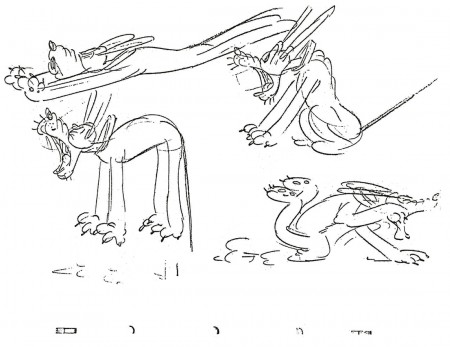 5
5
These drawings just never made it to the How to Draw Pluto
book that they sold at Disneyland in the Fifties.
Too much raw life and funny pictures.
All that’s left is for me to post the How to Draw Mickey and How to Draw Donald books from the Art Center at Disneyland. Next week.
Articles on Animation &Disney 28 Jul 2009 07:42 am
Old Black Magic
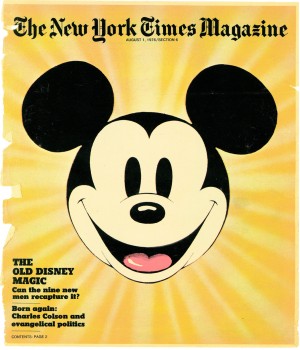 - Back in 1979, an eruption took place at the Disney studio. A group of the younger, talented artists at the studio – 20 of them – decided they couldn’t put up with it anymore and they walked out of the studio. Led by Don Bluth, they moved into his garage and a new studio came into being with competition for Disney’s troubled animation department.
- Back in 1979, an eruption took place at the Disney studio. A group of the younger, talented artists at the studio – 20 of them – decided they couldn’t put up with it anymore and they walked out of the studio. Led by Don Bluth, they moved into his garage and a new studio came into being with competition for Disney’s troubled animation department.
The rebellion didn’t just happen. Foment had started years earlier as Disney produced films such as The Black Cauldron, Pete’s Dragon and The Small One. Together with John Pomeroy and Gary Goldman, Bluth had put together an idea for a trial film, Banjo the Woodpile Cat, in 1975. The three got together after-hours and worked on their pilot film.
The article by John Culhane that appeared in the 1976 NYTimes really got this small group going. Disney was trying to put a little kick in their animation studio, and the kick ultimately resulted in a new animation studio – which, ironically, helped to get Disney back on track. It also got a couple of other studios going – Amblin and Ted Turner. They proved that there was money to be made in animation and slowly studios grew.
Here’s that NYTimes Magazine article:
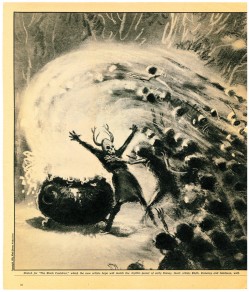 1
1 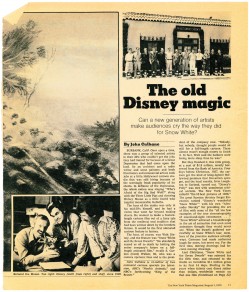 2
2(Click any page to enlarge to a readable size.)
In April, I wrote about Bluth and Banjo in two parts:
Part 1
Part 2
Animation &Layout & Design 27 Jul 2009 07:26 am
Piper spot
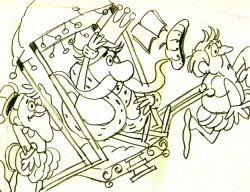 - Here’s some LO drawings for a commercial. It’s a riff on the Pied Piper. The Piper talks with a King character, who in the end gets young, after using the product.
- Here’s some LO drawings for a commercial. It’s a riff on the Pied Piper. The Piper talks with a King character, who in the end gets young, after using the product.
The art was obviously taped together and kept over the desk of the animator. The LOs were cut to fit into a large square and some of the drawing was done atop the tape.
This is a standard commercial done in New York during the 60′s. It has the look of almost any studio in town. I think this one was done at Pelican. I don’t know who the animator was nor what the product was that they were selling. Still, I thought the images worth sharing. It’s not a style that I particularly love, but it was sure a mainstay around NY back then. It looks like an offshoot of the work Paul Cloker was doing for Rankin Bass at about the same time.
As I said, it comes in a large taped-together mass. I give you the whole sheet, and then I’ve broken the drawings apart.
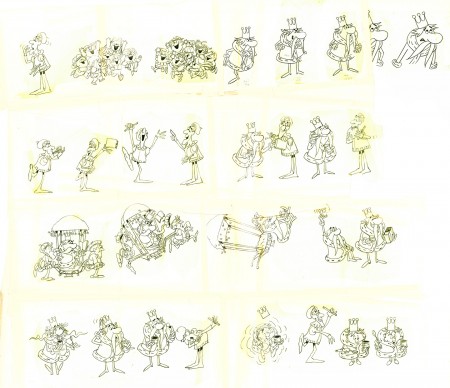
(Click any image to enlarge.)
Photos 26 Jul 2009 07:41 am
PhotoSunday – Bleecker Street Fair
- Walking to work yesterday morning, I saw a lot of stands just being set up. At first I thought it was some kind of independent film. For two blocks all of the laborers were Asian and they had unmarked trucks and rented vans. Soon I realized they were unloading material for stands they were going to set up. After I’d moved another couple of blocks of this, they were suddenly Italian-looking guys setting up bigger stands. Obviously, this was the annual (semi-annual?) Bleecker Street fair.
So I thought it time for my annual (semi-annual?) post.
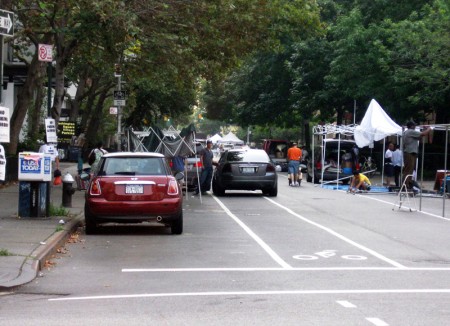
Here’s the first block I encountered with a few people setting up their stands.
They put the wares on the sidewalk and make it hard to pass by.

Moving on to the next block, we can see things are not quite as busy.

However the people that are there are seriously going about their work.
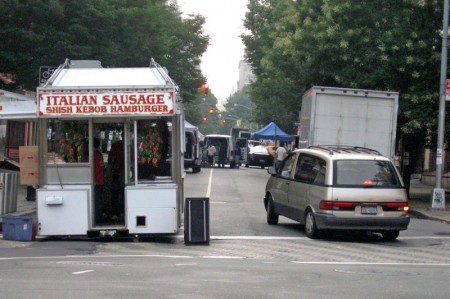
Naturally, the keystone vendor is the Italian Sausage place. I expect
they’re probably the first to be in place setting up the stand.

Six hours later. Things are hopping.

Plenty of people have turned out, as usual.

This year cel phones and electronics have turned out
in as great a force as those selling shirts and blouses.

Dresses, hats and sandwiches sit side by side.
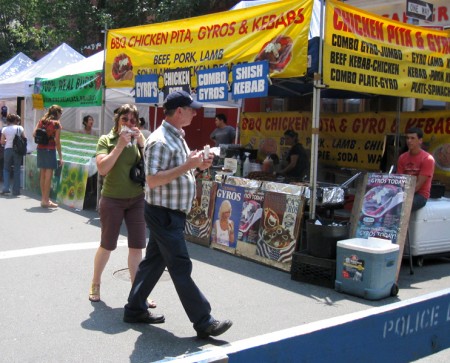
and food, food, food. All of it ethnic.

Even the grilled corn has a Mexican tint.

Of course, there’s plenty of meat.
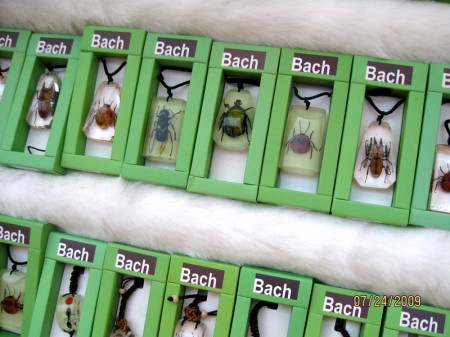
There’s also women’s jewelry made of encased, frozen bugs. Attractive.
Only $6 each.
There are about five of these stands.

However, I saw only one porta-potty.
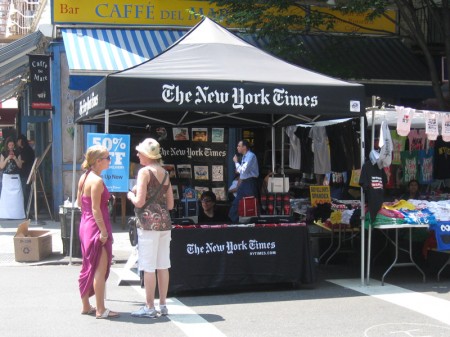
Even the NYTimes was represented, in case you wanted to subscribe. This
is the only vendor with a loudspeaker annoying the otherwise quiet crowd.
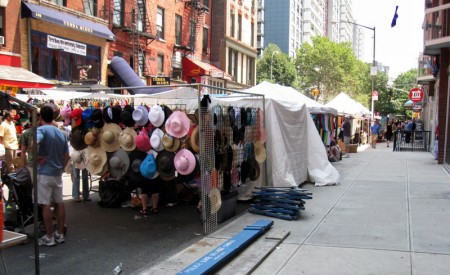
The sidewalks remained empty. All of the crowds
moved up and down the center of the stalls.

Still more blocks of vendors with plenty to sell.
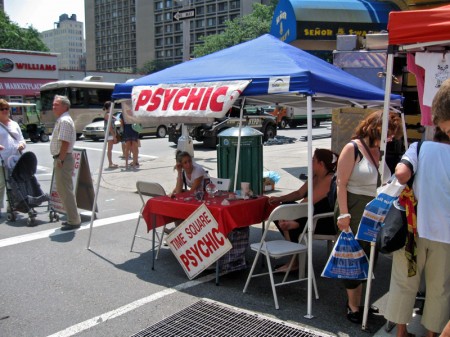
Needless to say, there were psychics ready to tell you about your future.
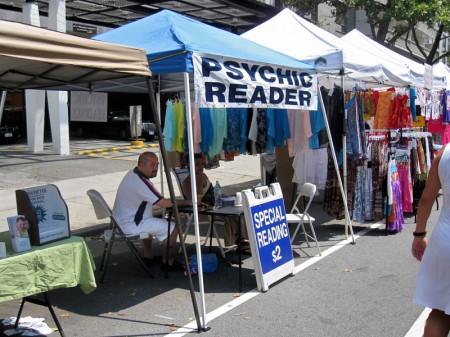
I saw two of them, neither busy, a block apart of each other.

I’m not quite sure if there’s a misspelling here.
Plenty o’ Mexican food.

The sidewalks remained empty. I took the opportunity to
head back with the fast move on the pedestrian path and
avoided the crowds shopping and window shopping.
Books &Illustration 25 Jul 2009 07:52 am
High in the Clouds – Part 2
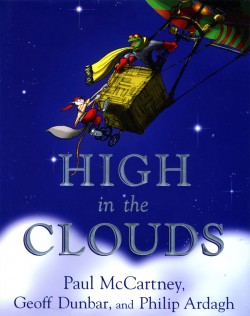 - I know, I know. I gave you the first part oh High in the Clouds weeks ago and haven’t followed up with the second part. Well, here it is.
- I know, I know. I gave you the first part oh High in the Clouds weeks ago and haven’t followed up with the second part. Well, here it is.
This is the storybook by Paul McCartney, Geoff Dunbar and Philip Ardagh that will be made into an animated film, directed by Rob Minkoff.
Dunbar is the animator/director who won lots of awards for some of his shorts and commercials. He’d animated a couple of McCartney songs in the past. Ardagh is a writer, and McCartney is McCartney.
Minkoff was the co-director of The Lion King, director of Stuart Little and The Haunted Mansion.
I have no real knowledge of this, but I assume it’ll be done in CG. Why else hire Minkoff when Dunbar’s already designed the hell out of the idea? Hopefully, it won’t look like all the other crap out there, but I have no confidence in anyone anymore.
So here are the rest of the illustrations. I haven’t read the book, and am not sure I will. It looks like a reworked/printed animated program, as it is.
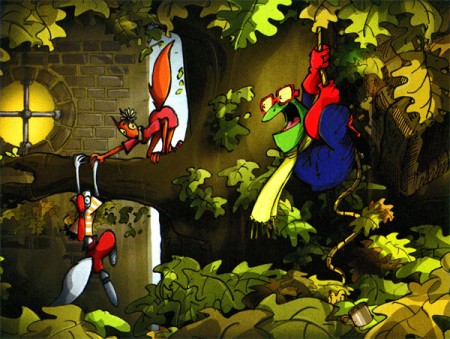 22
22(Click any image to enlarge.)
Commentary 24 Jul 2009 07:30 am
Magoo’s Carol & Little hop
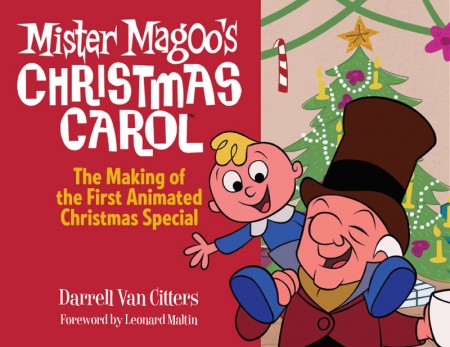 - I just received my copy of Darrll Van Citters’ new book, Magoo’s Christmas Carol: the making of the First Animated Christmas Special. This is a treasure. If you have any affection for this show or for animation in general I can only say GET THIS BOOK.
- I just received my copy of Darrll Van Citters’ new book, Magoo’s Christmas Carol: the making of the First Animated Christmas Special. This is a treasure. If you have any affection for this show or for animation in general I can only say GET THIS BOOK.
It’s beautiful; packed with storyboard, animation drawings, backgrounds and photos. Lots and lots of photos of the cast, crew, musicians, animators. Everything. It’s gorgeous. Darrell did the research, got the background material and put it all together in a beautiful package. He put his own money into it and didn’t get cheap at any stage of the process.
I haven’t read the book yet (I literally just received it), but I’m ready to push my work aside to start reading – that’s how anxious I am. Of course, I won’t do that, but I will write more and in length after I do read it.
I just wanted you to know that you should rush to get it. It’ll be sold at the San Diego Comic Con. For those, not able to get there just hit this link, and it’ll take you to the store where you can get copies signed or not.
This is a tiny sample of the art from the film’s production, though my scan doesn’t do it justice. The picture is better as printed in the book:
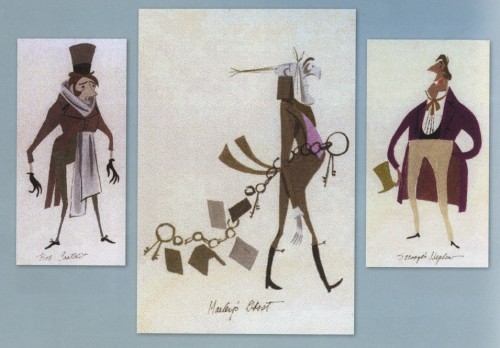
____________________
- If you want to see pure character in motion, take a look at the HBO documentary currently 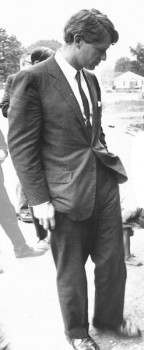 airing, the biography of Ted Kennedy. Teddy, In His Own Words is an excellent work that really gets into the history of this man and his family. However, there is one scene that keeps reverberating in my memory.
airing, the biography of Ted Kennedy. Teddy, In His Own Words is an excellent work that really gets into the history of this man and his family. However, there is one scene that keeps reverberating in my memory.
Ted had almost died in a plane crash; he broke his back. He was laid up in a hospital and at his home for a very long time. Finally, there was a point where he was to return to Congress.
The camera shows footage of Bobby Kennedy pacing outside the Capitol, waiting for his brother to arrive. Up pulls a big old car, and Bobby knows it’s his brother.
He starts to walk very quickly to meet Teddy and in that fast pace, Bobby actually does a miniscule stop and hop mid walk to greet him.
That little hop is so beautiful and endearing and emotional that I was just completely taken with the guy. It’s not too far from Gerald McBoing Boing’s walk in the original film, but here a real person is doing it, and the impetuous move is so delightful in its spontaneity.
If you get a chance, watch the show (no matter your political persuasion) these guys are history and there’s a big story of the last half of 20th Century here. It’s quite amazing.
And watch for Bobby Kennedy’s little jump; it’s so innocent and human.
There’s so much more to learn about animation by watching real life. Too many people these days put all their attention into studying animation and ignoring the real thing. That wasn’t the case with the real masters, and it’s no different today. Watch what you’re caricaturing.
Here’s the schedule of the documentary for July & August, but it’s also on their On Demand feature so you can watch it anytime.
Articles on Animation &Comic Art 23 Jul 2009 07:22 am
Keane Family Circus
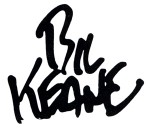 - I’ve had a bizarre attraction to Bil Keane‘s comic strip, The Family Circus. I was always sure that this strip might make a good animated show for television. In fact, A Family Circus Christmas directed by Al Kouzel was a good show. It came as a surprise when I first saw it, though there’s no reason I should have been. The story was first rate. The real surprise came years later when I learned that Bil’s son, Glen, had become one of the finest of the new-generation animators at Disney.
- I’ve had a bizarre attraction to Bil Keane‘s comic strip, The Family Circus. I was always sure that this strip might make a good animated show for television. In fact, A Family Circus Christmas directed by Al Kouzel was a good show. It came as a surprise when I first saw it, though there’s no reason I should have been. The story was first rate. The real surprise came years later when I learned that Bil’s son, Glen, had become one of the finest of the new-generation animators at Disney.
Bil Keane was interviewed in the Dec. 1975 issue of CARTOONIST PROfiles by the magazine’s editor, Jud Hurd, and I post it here:
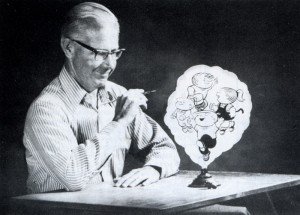 BIL KEANE is one of those fairly rare cartoonists who is just as funny on the speaking platform as he is onpaper in the two panels, THE FAMILY CIRCUS and CHANNEL CHUCKLES, he creates for THE REGISTER & TRIBUNE SYNDICATE. We heard another of Bil’s great talks again recent-ly, which prompted us to ask him some questions ahout cartooning for our magazine. BU and his famih- live in Paradise Valley, near Phoenix, Arizona.
BIL KEANE is one of those fairly rare cartoonists who is just as funny on the speaking platform as he is onpaper in the two panels, THE FAMILY CIRCUS and CHANNEL CHUCKLES, he creates for THE REGISTER & TRIBUNE SYNDICATE. We heard another of Bil’s great talks again recent-ly, which prompted us to ask him some questions ahout cartooning for our magazine. BU and his famih- live in Paradise Valley, near Phoenix, Arizona.
Q: Some time ago we did an interview with you that has caused a lot of comment. Your answers were hilariously funny, but not too informalive. l’d like this tobea serions interview that imparts to our readers the inner workings of Bil Keane.
KEANE: Fine. Which way to the X-ray machine?
Q: Seriously, could you give us a brief resumé of your art background?
KEANE: It’ll be quite brief because I never studied art. I taught myself to draw while I was in high school by imitating the cartoonists whose work I admired.
Q: Who were they?
KEANE: Each month I would have a different New Yorker magazine idol… George Price, Richard Decker, Peter Arno, Robert Day, Whitney Darrow, Barlow, Wortman… This was in the late thirties. l’d practice each style and technique until, in my mind, my drawings looked “similar” to the master. I still think this is an excellent way to develop a style. Eventually your own “thing” will emerge. I enjoyed studying cartoonists’ styles and learned to recognize them like handwriting. I used to play a game when Collier’s, The Saturday Evening Post, or American Magazine would arrive in the mail. As l’d turn a page on which there was a cartoon, l’d quickly cover the part of the cartoon bearing the signature and name the cartoonist who had made the drawing. Then, l’d lift my hand to see if I was right. I had a very high rate of accuracy. l’d be fooled only by a newcomer. I also became a fanatic cartoon clipper. I eut out every magazine cartoon I could find and pasted them in huge scrapbooks. I remember one time I was thrown out of a public library for slicing cartoons out of the current magazines with a razor blade. In fact, it was last week!
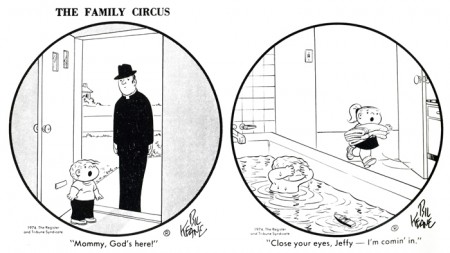
Q: Were magazine cartoons the only ones thaï interested you, or did you follow the newspaper cartoonists too?
KEANE: I never was an avid fan of the comic strip guys although I certainly admired most of the big ones. However, I had a real penchant for the newspaper panel cartoonists. George Lichty was my all-tirne favorite. I also liked H. T. Webster, Fontaine Fox, J. R. Williams, Gène Ahern and particularly Clare Briggs. Another genius to me was J. Norman Lynd who drew “Vignettes of Life.”
Q: Do you feel that most magazine gag cartoonists can develop a successful syndicated feature?
KEANE: Not necessarily. Some cartoonists are prolific and can turn out volumes of material from which a magazine editor may select the best. A syndicated cartoonist, for the most part, is his own editor. Unless he has the ability to discern which of his creations are good and which are poor, his feature will not hâve the batting average required to maintain success. I hâve seen highly successful magazine men fall fiât on their faces when attempting a 6 day a week feature done entirely by themselves.
Q: Some people write inspirations for cartoon ideas on the backs of old envelopes. Russell Myers carries a lape recorder and talks into it when he thinks of a “Broom Hilda” idea.
What system do you use for this?
KEANE: I don’t think of many “Broom Hilda” ideas, but when I do, I talk into the back of an old envelope.
Q: You promised this would he a serious interview.
KEANE: Frankly, for “Family Circus”, the only gimmick I use to think of ideas is thumbing through family type magazines where articles, pictures, ads, columns, etc., will suggest a setting or bring to mind one of the incidents that has happened in our home in the past. Given a specific setting or situation I can readily create a child’s reaction to it. I have a childish mind.
Q: Do you then write the caption or do the drawing first?
KEANE: It works both ways. Frequently the idea comes from a quote or phrase that is typical, or a youngster’s mispronounced word, or a childish musing such as: “Mommy, I need a hug.” Then all I do is create a cartoon that best fits with the line. At other times the picture depicts the identifiable scene such as a little girl dressed in her mother’s clothes, or a little boy running into the house with a bug in ajar, etc. Then I need to create a line to go with the illustration.
In most cases the caption is not really finalized till I am through with the drawing. As I am penciling the cartoon I keep saying the line over and over again to myself, changing it slightly to see how it sounds in various versions. I think it is terribly important in the kind of thing I do to have what a child says, or Mommy says, or whoever, sound natural, unmanufactured and clear.
Q: In “Channel Chuckles” you use a different type of humor than you do in “Family Circus.” Would you comment on this?
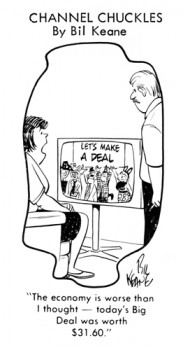 KEANE: “Channel Chuckles” humor is more satirical, zany and topical than “Family Circus.” The latter utilizes the identifiable, typical, “our kids have done the same thing” type of humor. Another entirely different field of humor that I like is the pun. I developed a solid background in this type of humor as a young boy when I was an avid collector of the old College Humor magazines that had been published in the 20′s and 30′s where piuis ran rampant. When I worked for the Philadelphia Bulletin in the late 40′s and during the 50′s I developed a Sunday color feature called “Mirth-quakers” which featured illustrated puns and the old “he-she” jokes (Sample: “Many big men born in this town?” “Nope, only little babies!”). For a few years, I drew a feature for the Saturday Evening Post “Pun-Abridged Dictionary. When my Sunday “Family Circus” page started in 1′ appended it with a weekly panel “Sideshow”, consisting of reader-contributed puns. The 25,000 letters a year that this feature drew, as well as the enthusiastic response other pun features convinced me that thi many pun-lovers in the country. (And quite few in the city, too, but they won’t admit it.)
KEANE: “Channel Chuckles” humor is more satirical, zany and topical than “Family Circus.” The latter utilizes the identifiable, typical, “our kids have done the same thing” type of humor. Another entirely different field of humor that I like is the pun. I developed a solid background in this type of humor as a young boy when I was an avid collector of the old College Humor magazines that had been published in the 20′s and 30′s where piuis ran rampant. When I worked for the Philadelphia Bulletin in the late 40′s and during the 50′s I developed a Sunday color feature called “Mirth-quakers” which featured illustrated puns and the old “he-she” jokes (Sample: “Many big men born in this town?” “Nope, only little babies!”). For a few years, I drew a feature for the Saturday Evening Post “Pun-Abridged Dictionary. When my Sunday “Family Circus” page started in 1′ appended it with a weekly panel “Sideshow”, consisting of reader-contributed puns. The 25,000 letters a year that this feature drew, as well as the enthusiastic response other pun features convinced me that thi many pun-lovers in the country. (And quite few in the city, too, but they won’t admit it.)
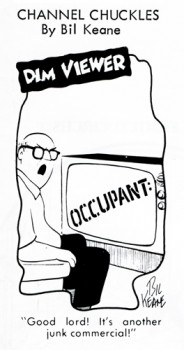 Q: You mentioned having worked for the Philadelphia Bulletin. Is this where you started and would you fill us in on your career to date?
Q: You mentioned having worked for the Philadelphia Bulletin. Is this where you started and would you fill us in on your career to date?
KEANE: My first job was or, Philadelphia Bulletin as a messenger in the year I graduated from high school. / years in the Army where I drew for Yank, Pacific Stars & Stripes, etc., I came back to the Bulletin with a fist full of my published service cartoons. This landed me a job in the news art department drawing spot cartoons and caricatures for the entertainment section which eventually led into my syndicate feature “Channel Chuckles” in 1954. I drew magazine cartoons for most of the markets, did a weekly Sunday comic for the Bulletin called “Silly Philly” (a little Quaker character based on William Penn), and edited a 16 page weekly supplement in the Sunday paper called “Fun Book”. When the income from “Channel Chuckles” and my free stuff enabled me to leave the 9 to 5 job at the Bulletin, my wife Thel (who I had met in Australia during the war and returned down under to marry in 1948) and I, along with our five small children moved to Paradise Valley, Arizona (near Phoenix) in 1959. Working at home for the first time with our little people underfoot, I discovered that most of the magazine cartoons I was selling had to do with family life and small children. I then decided to produce a second feature for the Register and Tribune Syndicate and introduced “Family Circus” in 1960.
Q: Wasn’t it originally called “Family CIRCLE”?
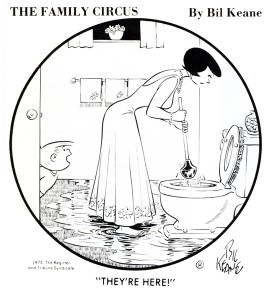 KEANE: Yes. I felt the name and circle format were a perfect combination. However, Family Circle Magazine (the one you read while waiting at the checkout counter in the supermarket) objected to the use of what they claimed to be their title and forced us to change the name of the feature. Frankly, I think if my syndicate had fought a small legal battle, we could have retained the CIRCLE title. The conversion was simple: I changed the last two letters from L-E to U-S. And, many feel that the CIRCUS title is more indicative of what goes on in the cartoon.
KEANE: Yes. I felt the name and circle format were a perfect combination. However, Family Circle Magazine (the one you read while waiting at the checkout counter in the supermarket) objected to the use of what they claimed to be their title and forced us to change the name of the feature. Frankly, I think if my syndicate had fought a small legal battle, we could have retained the CIRCLE title. The conversion was simple: I changed the last two letters from L-E to U-S. And, many feel that the CIRCUS title is more indicative of what goes on in the cartoon.
Q: Would you give us a rundown on your average working day?
KEANE: On most mornings I get up about 7:30, hit the studio (which overlooks the tennis court in case somebody wants to play) about 9, and work through most of the day with a break for lunch. It seems that the creative juices flow best late in the afternoon and will continue into the evening. I occasionally work after dinner till about 10 P.M. A comfortable couch in my studio is put to good use for 20 minute naps when 1 grow weary. Some mornings, especially in the summertime, I awaken about 4:30 A.M. and work till the morning Arizona sun is drenching Camelback Mountain with yellow. I then go back to bed (about 8 A. M.) for another hour of sleep. After breakfast I return to the studio to answer mail and to the more mechanical chores of drawing. It seems that the very early morning and early evening are the best times for uninhibited creative work. Of course, this work schedule varies around our social engagements and fairly frequent tennis matches. Totally, I average about 45 hours of real work each week and love every minute of it.
Q: An interviewer once asked you if “Family Circus” was based on your real life, and you replied that, on the contrary, your real life is based on the cartoon. If a particular situation gets a laugh in the feature, you try to work it into your home the following week. Bit, is that true?
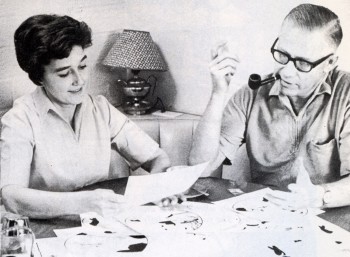 KEANE: No, but it’s a bit more amusing than the truth. My ideas are really based on our own family experiences and so are the characters. Our children aren’t as young as they once were, but, then who is? I have an excellent memory for detail and can recall vividly incidents from years ago. In fact, 1 even base a lot of the moods and childish attitudes in my cartoon on my own experiences as a small boy.
KEANE: No, but it’s a bit more amusing than the truth. My ideas are really based on our own family experiences and so are the characters. Our children aren’t as young as they once were, but, then who is? I have an excellent memory for detail and can recall vividly incidents from years ago. In fact, 1 even base a lot of the moods and childish attitudes in my cartoon on my own experiences as a small boy.
Bil and Thel review cartoons to submit.
Q: What are the ages of your five children now?
KEANE: The oldest is 25 and the youngest is 17. Glen, our 21 year old, is presently working in the animation department at Disney Productions in California.
Q: Do you get many cartoon ideas from reader mail?
KEANE: Well, not cartoon ideas per se. A young mother will occasionally write and say “Here’s something that happened in our house — maybe you can use it.” The incident she relates will form the nucleus of a situation to which I then apply my own family experience and whatever expertise I have as a gag creator. The result is usually a scene that took place in thousands of homes that very week. Basically, children never change and family life is universal and timeless.
Q: What advice would you give a young cartoonist aspiring to do a feature?
KEANE: I would highly recommend an art background. It is quicker in the long run than learning by your own mistakes. Also, stick to a subject with which you are familiar. This is the only way you will maintain high quality material. Don’t be a phony. Do what comes naturally.
Q: Obviously, since you live in Arizona, it has not been necessary for you to be close to the New York market to achieve success. Would you comment on this? KEANE: Even when I lived in Philadelphia I sold my cartoons to the Saturday Evening Post entirely through the mail and their offices were very close to the Bulletin Building where I worked. One of the beautiful things about this cartoon business is that it allows you to live anywhere there is a mailbox.
Q: How is your new cartoon book on tennis doing?
KEANE: It has only been out for a few months now, and already it’s selling into the dozens. Truthfully, the book (DEUCE AND DONTS OF TENNIS) is doing phenomenally well. Tennis is a popular subject and the $2.95 price is low enough to make it a hot item.
Q: What other books have you had published?
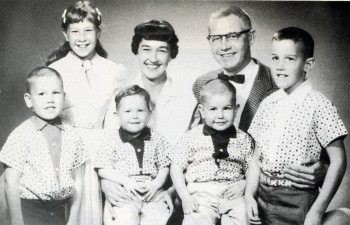 KEANE: Fawcett Gold Medal has published 12 paperback collections of my “Family Circus” cartoons. The newest, being released in October, is titled: “I CANT UNTIE MY SHOES!” The cover depicts Jeffy standing in a bathtub full of water. Several different publishing houses have put out books of my other cartoons. I collaborated with columnist Erma Bombeck on a book
KEANE: Fawcett Gold Medal has published 12 paperback collections of my “Family Circus” cartoons. The newest, being released in October, is titled: “I CANT UNTIE MY SHOES!” The cover depicts Jeffy standing in a bathtub full of water. Several different publishing houses have put out books of my other cartoons. I collaborated with columnist Erma Bombeck on a book
_________I believe that’s Glen to the far left._______________for Doubleday: “JUST WAIT TILL YOU HAVE CHILDREN OF YOUR OWN.” Erma is a neighbor and a genuinely funny lady.
Q: Not many cartoonists are funny on their feet as well as on paper. You have quite a reputation as a stand-up comedian delivering side-splitting talks at a microphone. Is this a natural talent or something you learned?
KEANE: It’s another thing I’ve taught myself through the years. I love to make people laugh and just eat up the immediate crowd reaction and applause, which is a pleasant change from drawing a cartoon and waiting weeks or months till after it is published for any reaction. When I give a talk, I write every word in advance. I plan the comments and one-liners carefully, making the material as topical and intimate as possible for that audience. In addition to concise, fresh material, the two important things for a stand-up comedian are delivery and timing. While giving speeches can be profitable, it is terribly time-consuming. I limit my personal appearances to only the ones I really want to do.
Q: Thanks, Bit. Do you have a final word?
KEANE: Yes — ZYZZOGETON. It’s on the last page of my dictionary. Before I close, Jud, I would like to say something nice about CARTOONIST PROfiles. I’d like to, but I can’t think of anything. Seriously, folks — your publication is an excellent chronicle of every phase of cartooning. We have all learned a lot about each other through your meticulous efforts. You deserve a big round of applause. (Jud gets a sitting ovation.) A hundred years from now people will be talking about Jud Hurd — which will give you an idea of how dull things are going to be in a hundred years.
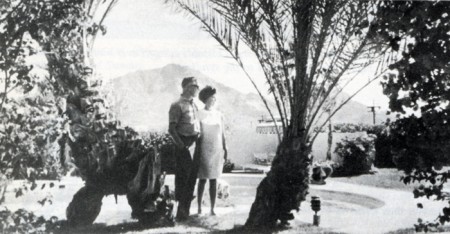
Bill, Thel and Paradise Valley.
Articles on Animation &Commentary 22 Jul 2009 07:12 am
Recap – theories
I’d written this a couple of years ago and posted it then, but I thought I’d expand on it a bit.
I have my own, odd thoughts about animators – great, master animators – these are the only ones I’m talking about.
I think there are two types of animator. Both types, I think, are brilliant but I have my preference. Basically it’s the same breakdown I have with live action actors: the difference between Laurence Oliver and Marlon Brando. Both are geniuses, but I’d go out of my way to see one of them more than the other.
One works from the outside in, and the other works from the inside out. It’s Royal Academy vs. Stanislavsky. 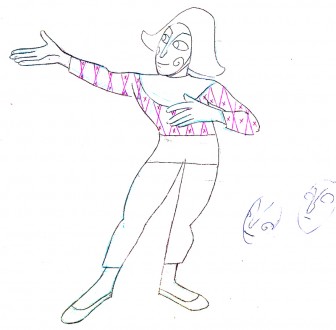
Animators:
- One is a brilliant mechanic of an artist who gets every pose every gesture just right. The movement of the character is perfectly flawless, the accents are always in the right place, the timing is perfect, and the weight captured is exact.
The character is developed but usually in a manipulated, studiously planned way. Usually, this animation, to me, is cold. Give the character a fake nose, and Laurence Olivier could be playing it.
(Art Babbitt, at the top of the triangle, is to me the model for this type of animator.)
(Babbitt dwng of Mime from Hubley’s Everybody Rides the Carousel)
.
Then there is the emotional animator. The poses, gestures, actions of the character are emotionally executed by the animator as if this were the only way it could come out. The drawings are often violent and immediate – pencils ripping through paper and dark blotchy artwork.
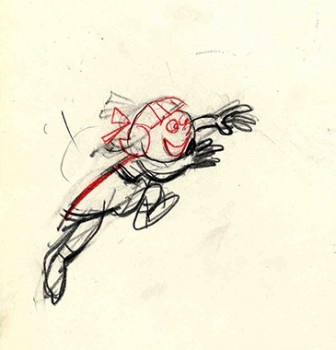 This animator often puts emotion above mechanics, but (s)he digs to the depth of the part to find a real living thing. It isn’t always beautiful, but there’s a gem of a character on the screen. Like any living organism it’s unexpected and natural. Often this type animator works straight ahead (Does dwg#1 first, then #2,
This animator often puts emotion above mechanics, but (s)he digs to the depth of the part to find a real living thing. It isn’t always beautiful, but there’s a gem of a character on the screen. Like any living organism it’s unexpected and natural. Often this type animator works straight ahead (Does dwg#1 first, then #2,
(Grim Natwick, to me, is the prime example of this type.)
No, I’m not saying if you draw dirty, rough, violent drawings you’ll be a great animator. I’m speaking somewhat metaphorically – although the two examples I gave actually did draw that way. I’m sure Art Babbitt did one or two rough,
(Grim Natwick drawing from a Mountain Dew spot.)________violent drawings in his life, but
__________________________________________________his animation feels tight, controlled, yet beautiful. Grim also did one or two clean drawings in his time – I have one, as a matter of fact, but his animation is controlled by his feelings, accumulated knowledge of craft, and emotions. It all feels immediate, spur-of-the moment. It’s alive!
I’ve only ever watched animated films with this guide going in the back of my head. Mind you, also, I have enormous respect for both of these types; it’s just that I prefer the emotional type. More than wanting my characters to think, I want them to feel.
My temptation, here, is to give the obvious list of animators and where they fall in my model, but I think for now I won’t. CGI also fits into this mold, but it’s not a great picture. I’m curious to hear what others think of this model.
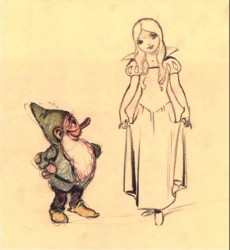 - I don’t mean for this post to turn into a “praise Grim Natwick” nor a “put down Art Babbitt” statement. I hope it doesn’t read that way.
- I don’t mean for this post to turn into a “praise Grim Natwick” nor a “put down Art Babbitt” statement. I hope it doesn’t read that way.
As I’ve said in the past, I treasure the drawings I have that were done by Art. I study and love every frame of any piece he’s ever animated. I just have more fun, personally – and I underline that word, personally, reviewing Grim’s animation.
Marlon Brando wasn’t a better actor than Laurence Olivier. They just came at it from different angles, and my preference has always been the more natural side of the acting world.
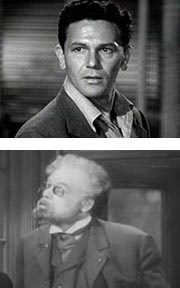 Back in the late thirties when the Group Theater was formed, these actors went to Russia to search out Stanislavsky, an acting teacher who preached at the bible of natural movement – getting in touch with your inner soul to project through the acting.
Back in the late thirties when the Group Theater was formed, these actors went to Russia to search out Stanislavsky, an acting teacher who preached at the bible of natural movement – getting in touch with your inner soul to project through the acting.
On Broadway, recently, was a revival of Awake and Sing. Clifford Odets was a member of the original Group Theater, and his plays reflected their “common man” attitude to theatrical productions. They weren’t trying to do spectacles or Royalty plays, they were trying to project the “average Joe” back from the stage. It changed theater, created Arthur Miller and a whole breed of acting styles. Compare, ex-Group Theater performer, John Garfield’s performances of the thirties with someone who was praised to the hilt back then, Paul Muni. Completely different acting styles – one natural and one overemotional and unrealistic.
The same was and is true of animators’ performances.
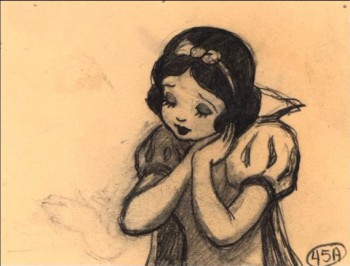 At Disney’s, these guys took their animation seriously. Some, such as Fred Moore and Norm Ferguson, thought they had it right and continued their own paths. Some looked into Stanislavsky and rejected it; others adopted it wholeheartedly. Still others, such as Grim Natwick, did it naturally and always had. Just as in the theater.
At Disney’s, these guys took their animation seriously. Some, such as Fred Moore and Norm Ferguson, thought they had it right and continued their own paths. Some looked into Stanislavsky and rejected it; others adopted it wholeheartedly. Still others, such as Grim Natwick, did it naturally and always had. Just as in the theater.
Next time you look at Fantasia, try just watching the acting styles. There’s nothing more Stanislavsky than Bill Tytla‘s scenes in Night On Bald Mountain, and there’s nothing less Stanislavsky than most of the animation in the Pastoral sequence.
